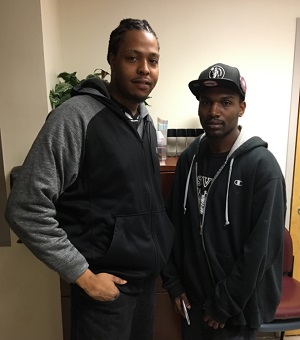
When violence hits a community it can be devastating and cyclical—some often respond with violence and others bury their pain in the absence of resources to help with proper coping. At Boston Medical Center, providers recognize this chain of events and take an active stance to intervene through an initiative changing countless lives—the Violence Intervention Advocacy Program (VIAP).
Several months ago, outside of an open mic night at a local club, Kynndall Martin and Thomas Grant—“brothers from other mothers,” as described by Kynndall—became victims of a random shooting. As they stood in the parking lot, a car drove by and its passengers flooded the scene with bullets. Thomas was shot twice and Kynndall was shot once—both were brought to Boston Medical Center’s Emergency Department (ED). There, they would be treated for more than their physical wounds.
Founded in 2006 by Thea James, M.D., VIAP begins in the ED where providers identify patients who have become victims of community violence. Two advocates—or “angels,” according to Thomas—by the names of Kendall Bruce and David Wiley, reach out to the identified patients, offering services to facilitate recovery through a trauma-informed model of care. On that October evening, Bruce and Wiley came to the bedsides of longtime friends Kynndall and Thomas, and a relationship blossomed between the foursome.
VIAP presents options for families that bring hope and healing to their lives. The providers assist the victims and their families with everything from addressing medical insurance issues to creating a safety plan as the victim returns to his or her neighborhood. In turn, this guidance strengthens others who are affected by violence and contributes to establishing safer and healthier communities.
“Our job is to build a rapport and determine what the client might need help with,” explains Wiley. “Nothing is cookie-cutter. Every care plan we create is tailored to the patient’s needs—whether that be food, court advocacy, assistance with Department of Children and Families or help with a doctor’s appointment, we’re there to support the quick fixes and the not-so quick fixes.” This wraparound approach, which includes home visits, is an organic way of learning more about the client’s personal environment and family situation.
“Angel” is not a farfetched description of Bruce and Wiley. A two-person team, the dynamic duo work round-the-clock to address victims of violence receiving care at BMC. “It feels amazing knowing someone is willing to help,” comments Kynndall. “It makes you feel good and hopeful. Something bad happened and I was drowning. They lifted me up and for that, I have the utmost respect.”
With Wiley’s help, Thomas received assistance with housing as well as partial custody over his children. For Kynndall, Bruce recognized he needed mentoring to help him reach his goals. But, most importantly, both just needed a friend. “They look at us as their peers,” says Bruce when describing the advocates’ success with connecting to their clients. “We’re from the neighborhood and understand personally what they’re going through, so they can relate to us.”
Since joining the program, Kynndall and Thomas have thrived and are working toward their dreams for themselves and their families. Both are employed as cooks, share custody of their respective children, live in safer environments and receive supportive care needed to manage the violence they endured. “I still think about that night and I still have a lot of anxiety,” says Kynndall, reflecting on the impact of his injury. “VIAP helped me mentally and helped me deal with the situation. Males and violence are together because we don’t have someone to talk to. I didn’t have anybody to help me excel. So having that extra person to push me, help me reach my goals and help me be a better person is important.”
VIAP has become a national model for programs handling urban, community violence, and since its inception, has helped thousands of individuals like Kynndall and Thomas whose lives have significantly improved as a result of VIAP’s guidance. “When you see a client doing well—someone who no longer needs your help and is asking how he can help—that’s the most rewarding,” concludes Wiley.
“It may be one or two people we’re helping but it changes the community in the long run. I know from personal experience—the people in my life who saw things I couldn’t see, changed me for the better. I know we’re doing the same thing,” adds Bruce.